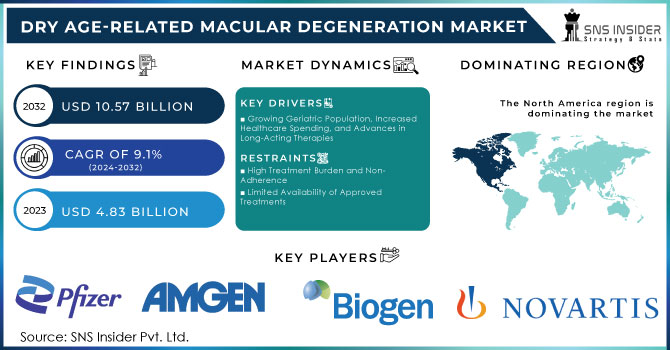Dry Age-Related Macular Degeneration Market Industry Trends: Growth, Demand, and Forecast 2024-2032
Dry Age-Related Macular Degeneration Market Industry Trends: Growth, Demand, and Forecast 2024-2032
|
The Dry Age-Related Macular Degeneration Market Revenue report by SNS Insider unveils a comprehensive analysis of market trends, drivers, and forecasts. The report indicates that the market is on a robust growth trajectory, driven by advancements in treatment modalities, increased awareness, and an aging global population. This report serves as a critical resource for stakeholders to understand the competitive landscape, key opportunities, and strategies for success.
Dry age-related macular degeneration (AMD) is one of the leading causes of visual impairment among older adults worldwide. Innovations in medical technology, coupled with extensive research and development efforts, are significantly enhancing treatment outcomes. With the integration of artificial intelligence in early diagnosis and a growing pipeline of potential therapeutic agents, the market holds immense promise for both patients and healthcare providers. The increasing prevalence of AMD, particularly among the geriatric population, is a critical factor boosting market growth. Rising healthcare expenditure and initiatives by governments to provide better diagnostic and treatment facilities further propel the demand. However, the high cost of treatment and lack of access to advanced therapies in developing regions remain challenges that need to be addressed. Get Free Sample Report @ https://www.snsinsider.com/sample-request/2627 Key Market Drivers and Trends
Regional Market InsightsThe report highlights North America as the leading region in terms of market share, attributed to advanced healthcare infrastructure, high awareness levels, and ongoing research activities. Europe follows closely, driven by increasing investments in healthcare and a focus on age-related diseases. Meanwhile, the Asia-Pacific region is expected to witness the fastest growth, owing to rising healthcare expenditure, a growing elderly population, and increasing adoption of innovative technologies. Challenges and OpportunitiesWhile the market presents immense opportunities, certain challenges persist. The high cost of advanced therapies and the limited accessibility in underdeveloped regions pose significant barriers. Addressing these issues through policy interventions and cost-effective solutions will be crucial for sustained market growth. Additionally, increasing collaborations between pharmaceutical companies and research institutions can pave the way for groundbreaking innovations in the field. ConclusionThe dry age-related macular degeneration market is at a pivotal juncture, with numerous growth opportunities on the horizon. By leveraging technological advancements, fostering collaborations, and addressing existing challenges, the industry can make significant strides in improving patient outcomes. About Us: Contact Us: Mayur Pande |
| Free forum by Nabble | Edit this page |


